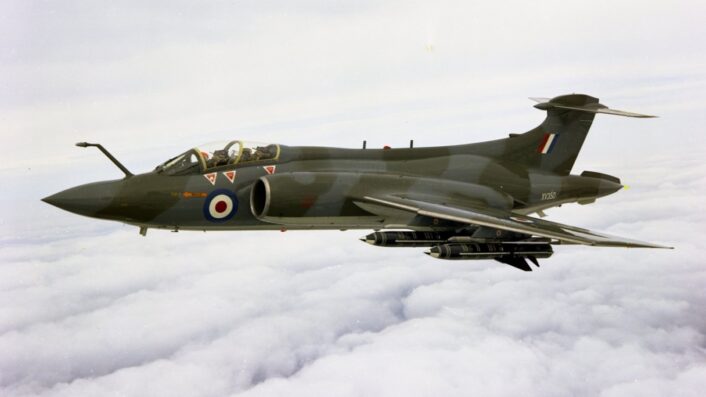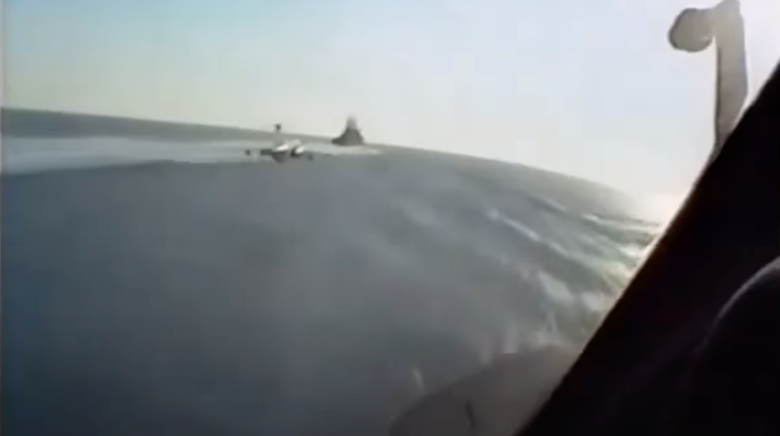This footage proves how low the RAF Buccaneers could fly during a maritime strike mission…
Blackburn Aircraft Company NA.39 was a carrier-borne, high-speed low-level strike aircraft which, in its production form, became famous as the “Buccaneer”. The first prototype, XK486, carried out its maiden flight from RAE Bedford on Apr. 30, 1958. Designed from the outset for low-level operation over land and sea, the first production Hawker Siddeley Buccaneer (as it was called after Blackburn & General Aircraft was absorbed into Hawker Siddeley Aviation in 1960), made its first flight on Jan. 23, 1962.
“The Hawker Siddeley Buccaneer made use of boundary layer control on wings and tailplane to allow operation from the relatively small British aircraft carriers,” says the BAE System website on the type. “The area-ruled fuselage (a design technique used to reduce an aircraft’s drag) featured a rotating bomb bay and two jet engines, integrated in the wing roots. The two crew were seated in-tandem, under a single sliding canopy, with a search radar mounted in the nose. Air brakes were incorporated into a bullet fairing at the rear of the fuselage, opening laterally to provide its braking action.”
The HS Buccaneer S Mk 1 entered service with the Royal Navy in 1963. A subsequent variant, designated the HS Buccaneer S Mk 2 (which is readily identified by its large elliptical engine air intakes) was re-engineered to accommodate the more powerful Rolls-Royce Spey engine, which was required for carrier take off. All Royal Navy squadrons were converted to the improved S.2 variant by the end of 1966. After withdrawal from Royal Naval service (upon the retirement of their carriers in 1978), 62 x HS Buccaneer S Mk 2 were transferred to the RAF, with the fleet being augmented by another 49 ‘new-build’ HS Buccaneer S Mk 2B’s. These new aircraft featured an increased all-up weight, larger weapons bay, increased fuel capacity and 16,000 lb weapon load.
The first RAF unit to receive the Buccaneer was 12 Squadron at RAF Honington in October 1969, in the maritime strike role. At peak strength, at total of 6 squadrons were flying the Buccaneer: along with the 12 Squadron, the 15 Squadron, 16 Squadron, No. 237 OCU, 208 Squadron, and 216 Squadron.

The RAF Buccaneers were famous for carrying out training flights at ultra low level. This was required in the maritime strike mission before stand-off weapons were develop, to escape detection of enemy radars and get close to the target warships. The British jets often deployed from their homebases to RAF Gibraltar in the Mediterranean to carry out a low-level anti-shipping missions. The video in this post was filmed during one of those deployments, most probably towards the end of the service with the RAF, and gives an idea of how low the Buccaneers of the 12 Sqn flew during such over water missions.
The take off at 00:45 and the low level flying at the 2:25 mark are remarkable.
The last Buccaneers were withdrawn from RAF service in 1994, about three years after taking part in the First Gulf War in a role its designers hadn’t foreseen: the “buddy lasing”. In fact, as already explained in a story published earlier this year, back in 1991, a new role emerged when the RAF had started using Paveway LGBs (laser-guided bombs). Such bombs follow a laser signal towards the target. The Buccaneer was adapted to carry the Pave Spike laser designator pod, that could illuminate the target for bombs dropped by further Buccaneers, Jaguars or Tornados. This is also called “buddy lasing”: a laser-equipped aircraft provides the final guidance for a laser-guided weapon delivered by another aircraft, a way of conducting an air strike that the RAF used also 20 years after Desert Storm, in 2011, during the Air War in Libya, when Tornado GR4s flew joint sorties with Eurofighter Typhoons with “Tonka” navigators assisting Typhoon pilots with laser targeting.









